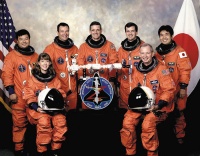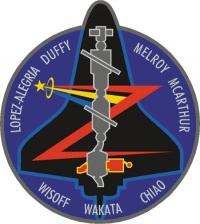STS-92
From The Space Library
 | |
| Organization | NASA-Office of Space Flight (United States) |
|---|---|
| Mission type | Human Crew |
| Launch date | October 11, 2000 |
| Launch vehicle | Space Shuttle |
| Launch site | Cape Canaveral, United States |
| COSPAR ID | 2000-062A |
| Inclination | 51.6 degrees |
| Experiments | Here |
| Alternate Names | 26563 |
| Additional Information | Here |
| Data Collection | Here |
| Payload Mass Up | 12704.66 kg |
| Payload Mass Down | 2865.45 kg |
| Orbiter | Discovery |
| Lift Off Mass | 2,054,816.36 kg |
| Orbiter Weight at Liftoff | 115,366.82 kg |
| Orbiter Weight at Landing | 92,934.09 kg |
| Landed | Concrete runway 22 at Edwards Air Force Base, Calif. |
| Orbits of Earth | 203 |
| Orbital Altitude | 173 nautical miles (259 statute miles) |
Contents |
[edit] Crew
- Commander: Brian Duffy
- Pilot: Pamela Ann Melroy
- Payload Commander:
- Mission Specialist 1: Koichi Wakata, National Space Development Agency of Japan
- Mission Specialist 2: Peter J.K. (Jeff) Wisoff
- Mission Specialist 3: Leroy Chiao
- Mission Specialist 4: William S. McArthur Jr.
- Mission Specialist 5: Michael E. Lopez-Alegria
- Payload Specialist 1:
- Payload Specialist 2:
ISS/Mir Crew Transport
[edit] Mission
STS 92 was an American shuttle spacecraft that was launched from Cape Canaveral at 23:17 UT. The crew carried out space walks to install a 8.5 ton, aluminum Z-1 truss on the Unity module. The truss was intended to support a football-field sized solar array that will be installed during a later mission in December 2000. A triaxial attitude control gyroscope and a Ku-band satellite dish were then installed on the truss. The crew also installed a major 1.2 tonne docking port named Pressurized Mating Adapter (PMA) on the Unity module. They fired thrusters in the shuttle to raise the altitude of the ISS. Among other activities was a practice run of a device named SAFER (Simplified Aid For EVA Rescue) to rescue an untethered astronaut and to assess whether a dead or gravely ill spacewalker could also be retrieved back to a shuttle or the ISS. The shuttle landed in Edwards AFB in California on 24 October at 20:59 UT. A Cape Canaveral landing had to be cancelled because of persistent bad weather in southern Florida. The potential uses of the ISS for furthering science and engineering are outlined in a NASA site, http://spaceflight.nasa.gov/station/science/ STS 92 was the 100th shuttle mission, almost coinciding with the 100th successful launch of the European Ariane rocket.
[edit] EVA
Extravehicular Activity (EVA) conducted by Leroy Chiao, William McArthur, Jeff Wisoff, and Michael Lopez-Alegria during four spacewalks for a total of 27 hours, 19 minutes. EVA 1, Chiao and McArthur, 6 hours, 28 minutes. Chiao and McArthur relocated the S-band antenna support assembly on the Z1 truss and connected Z1-to-Unity umbilicals. EVA 2, Wisoff and Lopez-Alegria, 7 hours, 7 minutes. During EVA 2, Koichi Wakata used the shuttle's robotic arm to grapple and install PMA-3 on Unity's nadir port. Wisoff and Lopez-Alegria connected cables between PMA-3 and Unity. EVA 3, Chiao and McArthur, 6 hours, 48 minutes. Chiao and McArthur installed two DC-to-DC converter unit heat pipes on the Z1 truss and relocated the Z1 keel pin assembly. EVA 4, Wisoff and Lopez-Alegria, 6 hours, 56 minutes. Wisoff and Lopez-Alegria removed a grapple fixture on the Z1 truss. Wisoff and Lopez-Alegria also performed a safety protocol test, a flight evaluation of simplified aid for EVA rescue (SAFER).
[edit] Payload
International Space Station (3A); Z1 truss; pressurized mating adapter 3 (PMA-3); cargo transfer
[edit] Books about the Space Shuttle Program
Buy This Book Click here |
Buy This Book here |
Buy This Book Click here |
Buy This Book Click here |





